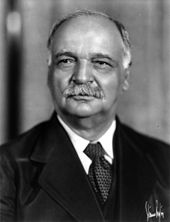Charles Curtis
Charles Curtis (* 25. January 1860 in Topeka , Kansas , † 8. February 1936 in Washington, DC ) was an American politician of the Republican Party and from 1929 to 1933 the 31 Vice President of the United States .
His mother came from the Kansa people . Charles Curtis was the first - and so far the only - Native American politician who succeeded in holding such high political offices.
Curtis studied law and practiced as a lawyer in Topeka . From 1885 to 1889 he was a district attorney in Shawnee County . From 1893 to 1907 he was a member of the US House of Representatives . On January 23, 1907, he was elected as the successor to the resigned Joseph R. Burton as a US Senator - as the first politician of Indian descent. At times he also held the office of pro tempore President in the Senate . After a failed re-election, he left office in 1913, but became a senator again in 1915 and was successfully re-elected in 1920 and 1926.
In the 1928 presidential election he won a major victory as a running mate alongside Herbert Hoover against the Democrats Al Smith and Joseph Taylor Robinson , whereupon he moved from the Senate to the office of vice president in 1929. The defeat in the 1932 presidential election also ended the political career of Curtis, who died on February 8, 1936 at the age of 76 after a heart attack .
In 1932, Curtis opened the Los Angeles Summer Olympics .
Charles Curtis was the author of the Curtis Act of 1898, which stole 90 million acres from the Indian tribes in Indian territory and cost the tribal governments their autonomy. The Curtis Act allowed non-tribal people to colonize Oklahoma . Charles Curtis believed in individual land ownership and opposed tribal land owned. He believed that only an adaptation of the tribes to western ideals could guarantee the continued existence of the Indians. Tribal governments were in his view a hindrance to the progress of the Indians. The act led to the dissolution of the Cherokee Nation . Charles Curtis himself was unhappy with the act, however, as it went through several revisions and had little in common with his original design.
literature
- Jules Witcover: The American Vice Presidency: From Irrelevance to Power. Smithsonian Books, Washington, D. C. 2014, ISBN 978-1-58834-471-7 , pp. 290-297 (= 31. Charles Curtis of Kansas ).
Individual evidence
- ^ Oklahoma Historical Society CURTIS ACT (1898).
- ^ Native Heritage Project The Curtis Act of 1898: The Curtis Act called for the abolition of tribal governments on March 6, 1906. It was intended to establish the concept of individual land holdings.
- ^ Native Heritage Project The Curtis Act of 1898: He believed that the Five Civilized Tribes needed to make changes. He thought that the way ahead for Native Americans was through education and use of both their and the majority cultures, but he also had hoped to give more support to Native American transitions.
- ↑ uslegal Curtis Act Law and Legal Definition
Web links
- Charles Curtis in the Biographical Directory of the United States Congress (English)
- Charles Curtis in the database of Find a Grave (English)
- Curtis, Charles - Biography (English)
- Charles Curtis in the Miller Center of Public Affairs of the University of Virginia (English)
- Newspaper article about Charles Curtis in the 20th century press kit of the ZBW - Leibniz Information Center for Economics .
| personal data | |
|---|---|
| SURNAME | Curtis, Charles |
| BRIEF DESCRIPTION | American politician |
| DATE OF BIRTH | January 25, 1860 |
| PLACE OF BIRTH | Topeka , Kansas |
| DATE OF DEATH | February 8, 1936 |
| Place of death | Washington, DC |





